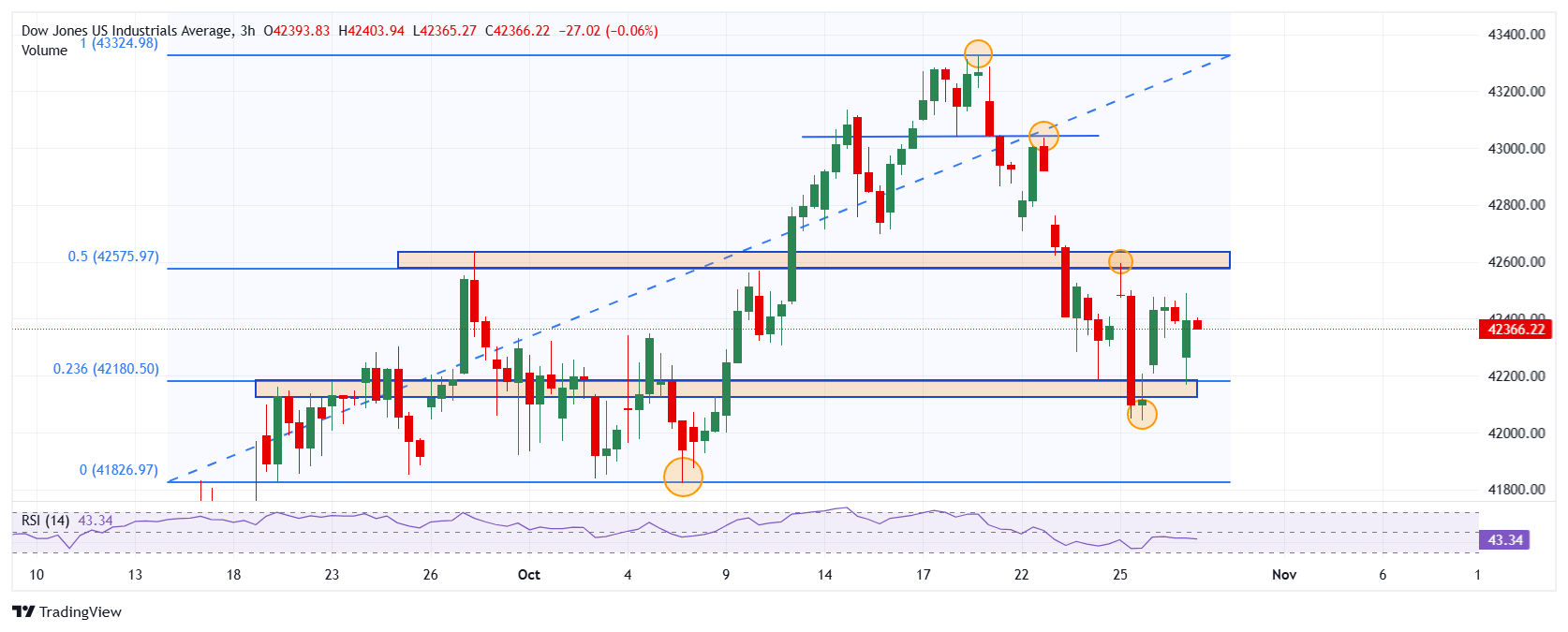- The Dow Jones index loses 0.06% at the beginning of the day.
- The Nasdaq 100 rises 0.38% on the day.
- The S&P 500 falls 0.03% daily.
The Dow Jones operates with losses and resumes its bearish outlook, reaching two-day lows at 42,166.
The Dow Jones Industrial Average began trading at 42,396, while the Nasdaq 100 technology index began trading Tuesday at 20,376. The S&P 500 opened at 5,829, hitting October 25 lows of 5,798.
The Dow Jones is trading lower, dragged down by Home Depot and P&G
The Dow Jones Industrial Average shows a slight daily drop of 0.06%, trading at 42,388, weighed down by Home Depot (HD) and P&G (PG). HD loses 1.61%, trading at $396.43, while PG falls 0.78%, trading at $168.15.
On the other hand, McDonald’s Corporation rises 0.78% after exceeding analyst estimates in its quarterly report, obtaining revenues of $6.87 billion and earnings per share of $3.23 compared to the projected $6.82 billion. and a consensus earnings per share of $3.2.
Nasdaq 100 trades in positive territory ahead of Alphabet and Advanced Micro Devices earnings reports
The Nasdaq 100 technology index gains 0.38% early in the session, signing its fourth consecutive bullish session, trading at the time of writing at 20,441.
The gains in the index are led today by the shares of Cadence Design (CDNS), which have soared 11.04% after an excellent quarterly report, obtaining revenues of 1.22 billion dollars and an earnings per share of 1.64 $, exceeding the $1.18 billion in revenue projected by analysts. CDNS is trading above $281.19, reaching highs not seen since October 15.
Investors’ attention will be on the financial reports of Alphabet (GOOG) and Advanced Micro Devices (AMD) at the market close. The analyst consensus expects revenues at GOOG of $86.37 billion and earnings per share of $2.04, while AMD is projecting revenues of $6.71 billion and earnings per share of $0.9235.
The S&P 500 presents marginal losses after US economic data
The S&P 500 stock index falls 0.03% on the day, currently trading above 5,825 after JOLTS job openings fell to 7.44 million in September compared to the 7.99 million expected, while the US trade balance extends its deficit to $108.2 billion in September preliminary reading. In contrast, consumer confidence from the American Conference Board (CB) registered an increase of 9.5 points in October, standing at 108.7 compared to 99.2 in September.
Investors will focus on Visa (V)’s earnings report at market close, with analysts projecting the company to report revenue of $9.49 billion and earnings per share of $2.58.
Technical analysis of the Dow Jones
The Dow Jones Industrial Average reacted higher to short-term support given by the October 25 low, located at 42,043, in line with the 23.6% Fibonacci retracement. We see the next important support zone at 41,821, the pivot point of October 7.
On the upside, the closest resistance is at 42,956, the October 25 high that coincides with the 50% Fibonacci retracement. We observe the next key resistance level at 43,036, the pivot point of October 22. Relative Strength Index at 43 shows a slightly bearish bias with intentions to test the key 42,200 level in the near term.
Dow Jones 3-hour chart

The Dow Jones FAQs
The Dow Jones Industrial Average, one of the world’s oldest stock indices, is made up of the 30 most traded securities in the United States. The index is weighted by price rather than capitalization. It is calculated by adding the prices of the securities that comprise it and dividing them by a factor, currently 0.152. The index was founded by Charles Dow, also founder of the Wall Street Journal. In recent years it has been criticized for not being sufficiently representative, since it only follows 30 companies, unlike broader indices such as the S& P 500.
There are many factors that drive the Dow Jones Industrial Average (DJIA). The main one is the aggregate performance of its component companies, revealed in quarterly corporate earnings reports. US and global macroeconomic data also contribute, influencing investor sentiment. The level of interest rates, set by the Federal Reserve (Fed), also influences the DJIA, as it affects the cost of credit, on which many companies largely depend. Therefore, inflation can be a determining factor, as well as other parameters that influence the Federal Reserve’s decisions.
The Dow Theory is a method for identifying the main trend of the stock market developed by Charles Dow. A key step is to compare the direction of the Dow Jones Industrial Average (DJIA) and the Dow Jones Transportation Average (DJTA) and only follow trends where both are moving in the same direction. Volume is a confirmation criterion. The theory uses elements of maximum and minimum analysis. The Dow theory proposes three phases of the trend: accumulation, when the smart money begins to buy or sell; public participation, when the general public joins the trend; and distribution, when the smart money abandons the trend.
There are several ways to trade the DJIA. One of them is to use ETFs that allow investors to trade the DJIA as a single security, instead of having to buy shares of the 30 companies that comprise it. A prominent example is the SPDR Dow Jones Industrial Average ETF (DIA). Futures contracts on the DJIA allow traders to speculate on the future value of the index, and options provide the right, but not the obligation, to buy or sell the index at a predetermined price in the future. Mutual funds allow investors to purchase a portion of a diversified portfolio of DJIA securities, providing exposure to the global index.
Source: Fx Street
I am Joshua Winder, a senior-level journalist and editor at World Stock Market. I specialize in covering news related to the stock market and economic trends. With more than 8 years of experience in this field, I have become an expert in financial reporting.







